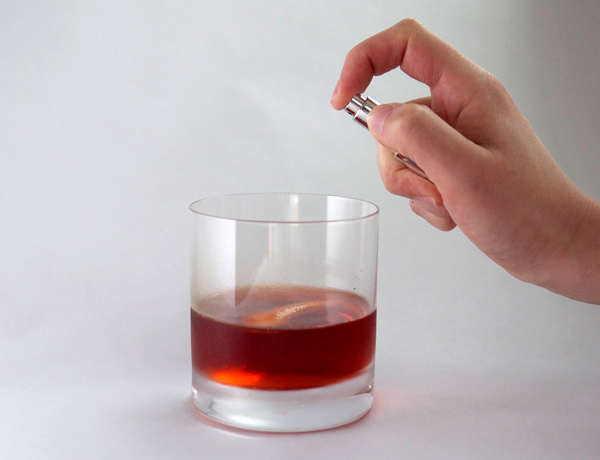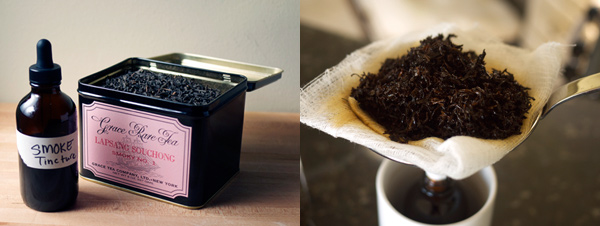What makes a cocktail distinct is its ability to have different aromas co-mingle without stepping on each other's toes.
In a Manhattan you have the spice from the Rye that is complemented by the bitterness of the vermouth and topped by either the syrupy sweetness of the cherry or the freshness of a citrus peel. In a Sazerac you have two distinct liquors with arguably opposite flavors--Rye and Absinthe--that somehow manage to beautifully cohabitate in the glass.
Usually, the aromas are inherent to the ingredients you're mixing into the cocktail, but often they're added in more artificial ways like garnishes (cherries or citrus peels or candied ginger), or flavored simple syrups (which impart a flavor and sweetness at the same time). Another way to include a separate aromatic layer is with a tincture. Elana, from Stir and Strain, describes a tincture:
"Well, I read a bit for this post and pretty much what it came down to is that a tincture is the essence of the ingredient you steep in a neutral grain alcohol. It can be used in small amounts by itself, or added with more ingredients for compounds like bitters. Because it is steeped in a high proof alcohol, you don’t shoot it back in a giant gulp. It would also probably taste awful. With an infusion, you are also extracting the essence of what you are putting into the alcohol, but it is co-mingling with the base spirit for a new combined flavor. You might see sour cherry bourbon, lemon lavender gin, something along those lines."
She went with Smoke as an aroma, for Mixology Monday's theme, to complement a Boulevardier Cocktail.
"For this particular use of smoke in a cocktail, I didn’t want the drink to continue to be steeped in smoke. What I wanted here was for the initial smell to be a deep, meaty smoke aroma, and then when tasted, you were only getting the cocktail. This beautiful smoky aroma would make the drink a surprise for the person drinking it, hopefully a pleasant shock. The aroma would then dissipate as one continued to finish the drink. I chose a Boulevardier to accompany the smoke aroma."
Usually when we think of smoky drinks our mind goes to Scotch, which, if from the Islay region, has a distinct smokey, "peaty" aroma, that comes from when the barley is toasted using smoke from burning ocean peat. In the case of Scotch, the smoky flavor is imparted long before the distillation process. However, sometimes a smoke flavor is added afterward, as more of a finishers. I've had smoked bourbons where there already distilled and aged bourbon is smoked (usually with mesquite).
The flavor is much less subtle than in Scotch and it kind of tastes like you're drinking a glass of bourbon while standing next to a barbecue.
A tincture, on the other hand, is added to the cocktail as one of several components, rather than integrated directly with the primary liquor, which allows the aroma to comfortably exist alongside the flavors of the drink. The tincture doesn't overpower the taste of the cocktail itself, as it's more of a perfume than an ingredient. The initial smell of the smoke layers on another dimension for the palate, but ultimately the flavor of the cocktail remains unchanged.
Lapsang Souchong Tincture
From Stir and Strain
1/2 cup grain alcohol (I have 151 proof everclear)
1/4 cup Lapsang Souchong Loose Tea
Loose Tea
1/4 cup Lapsang Souchong
Combine the two ingredients in an airtight glass container. Let sit for two weeks in a cool, dark place. Gently shaking every few days. After two weeks, strain with a fine mesh strainer with a double layer of cheesecloth. You want to make sure you are getting all the tiny bits of tea out. If you still see residue, strain an additional time. Store in a dropper bottle.
Lapsang Souchong tea has a heavy smoke aroma. When you open the box it’s like getting hit with a face full of wood smoke. As a tincture, the essence gets meatier (as in smoked meat).
Being so easy to make, it seems silly not to experiment with different kinds to jazz up future home bar creations! I for one, being a lifelong fan of Lapsang Souchong tea, cannot wait to try this.
For the Boulevardier Cocktail recipe, using the smoke tincture, visit Stir and Strain!




Do you want to buy lapsang souchong loose tea in Canada? Then visit Teamatica.
ReplyDelete